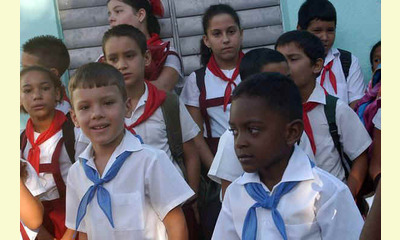|
|
Agreements with organizations to work with and for the children [Cuba]
un articulo por Maria Elena Alvarez Ponce, Agencia Cubana de Noticias
With an eye to the formation of the "new pines", the José Martí Pioneers Organization on Wednesday signed agreements to strengthen their working relations with a dozen agencies and institutions.

click on photo to enlarge
Present in all the agreements is the idea of Jose Marti, "For the children we work", knowing that they are "the hope of the world." This slogan has become a fervent tribute to the national hero of Cuba, on the occasion of the 160th anniversary of his birth.
Among the organizations signing agreements are the Ministries of the Revolutionary Armed Forces and the Interior, the National Union of Companies for Recycling, the José Martí National Library, the Civil Defense and the National Institute of Hydraulic Resources. Others include the Cuban Movement for Peace and Sovereignty of Peoples, the National Council of Houses of Culture, the Philatelic Federation of Cuba, the Birthplace Museum of Camilo Cienfuegos and the Cuban Meteorological Society.
The working agreements for 2013 were signed In the Ernesto Guevara Central Palace of Pioneers. Their priorities are the work of professional and vocational training, the installation of which in Havana is a reference for Pioneers nationwide.
Other priorities, no less important, are patriotic education, environmental education, forging of values, and the promotion of a strong culture of peace and respect for future generations, explained Yamile Ramos Cordero, president of the Pioneer Organization.
Before a crowd of children and adolescents and accompanied by the pioneers of Moncada and of "José Martí" ( the first and second levels), the agreements were signed and the joint efforts were deemed valuable to encourage the habit and the need to read, study, learn , enlarge horizons and cultivate the spirit.
It was emphasized that the agreements are a "dead letter" unless they are followed up with concrete actions that invite and ensure, through competition and many other activities, the increased real and conscious participation by the more than one million Cuban pioneers in the life of their school , their community and the society at large.
On behalf of the signatory agencies, institutions and organizations, Silvio Platero Irola, President of the Cuban Movement for Peace and Sovereignty of Peoples, welcomed this opportunity to imagine the future and work for a better world and Cuba.
"To contribute to the full and integral training of new generations is neither more nor less than a commitment to the future," emphasized the lead manager of the NGO, and she spoke of the children as the greatest treasure and pride of the nation.
"What other country can inspire almost half a million infants paint the image of peace?" Platero Irola asked, noting the recognition that Cuba received from the World Peace Council at its most recent meeting, for the extraordinary participation of its younger citizens in a contest for that purpose.
(Click here for a Spanish version of this article)
|








|
DISCUSSION
Pregunta(s) relacionada(s) al artículo :
What is the best way to teach peace to children?,
* * * * *
Comentario más reciente:
Maria Montessori believed that peace was innate within children. Her timeless educational philosophy was developed around this basic understanding. Perhaps all we need to do as teachers is to provide stimulating learning environments that validate this knowing and understanding and nurture it. We may not have to actually teach it, Sharing peace-building stories gently attends to this. Strong, creative and imaginative peace-building characters who focus upon win-win and have faith in peace being possible are at the centre of the story plots. In Hassaun Ali-Jones Bey's (Boundless Gratitude http://boundlessgratitude.com/products.html ) unique and mesmerising story, Black Ink is such a character who bravely crosses the universe seeking validation of what he knows in his heart. The magical character also models all the important peace-building values, understandings and actions needed for peace-building. I believe also that peace-building must be modelled and the whole teaching-learning environment should reflect similar values, understandings and actions...as is the primary focus of the Save the Children Australia UN Global Peace School Program upon which I am presently fortunate to be working. . ... continuación.

|
|









